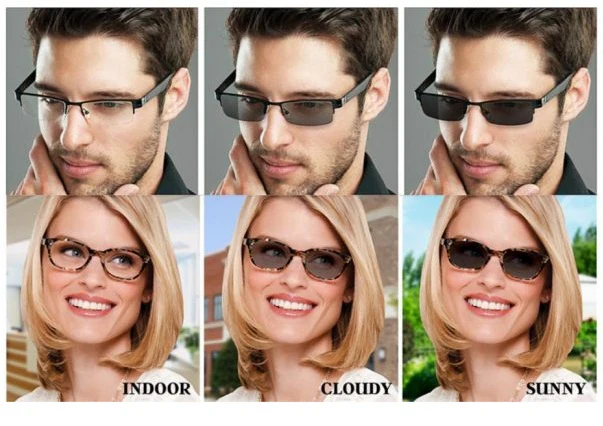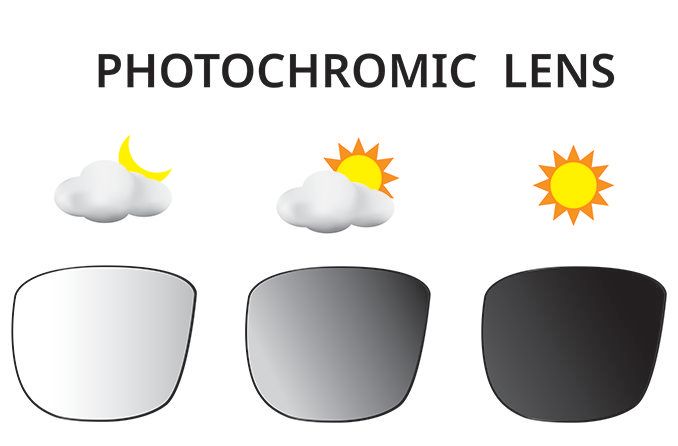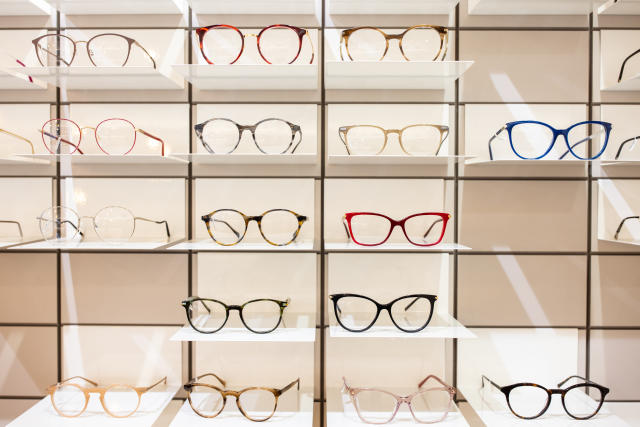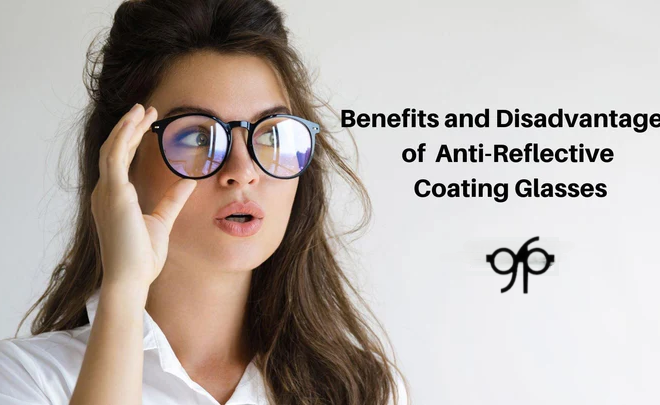
A Smart Response to the Sun: Meet Photochromic Lenses
Photochromic lenses have revolutionized the world of eyewear by seamlessly combining style and functionality. As an optical expert, I’m excited to share an in-depth exploration of these innovative lenses. Whether you’re considering them for everyday use or curious about their advantages and limitations, this article will offer clear insights into the technology and practical aspects of photochromic lenses.
What Is a Photochromic Lens?
Photochromic lenses are a type of optical lens that darkens automatically in response to ultraviolet (UV) light. When you step outdoors on a bright day, the lenses react to the increased UV exposure by tinting; when you move indoors or away from sunlight, they gradually return to a clear state. This dynamic adjustment makes them versatile for both indoor and outdoor environments.
How They Work
The secret behind photochromic lenses lies in special molecules embedded within the lens material. These molecules undergo a chemical reaction when exposed to UV light, causing the lens to darken. Once the UV stimulus is removed, the molecules revert to their original form, and the lens lightens. This process is both rapid and reversible, ensuring continuous comfort and protection.
A Blend of Science and Convenience
For many, the appeal of photochromic lenses is their ability to adapt to changing lighting conditions. No longer do you need to carry an extra pair of prescription sunglasses or swap between different lenses; a single pair of photochromic lenses can serve multiple purposes. This blend of convenience, safety, and technology is what makes them a popular choice among optical wearers.
Are Photochromic Lenses Good for Eyes?
One of the most common questions surrounding photochromic lenses is whether they are beneficial for eye health. The short answer is yes—they offer several advantages that can help protect and enhance your vision.
Protection Against UV Rays
Excessive exposure to UV rays can lead to eye strain, cataracts, and other long-term ocular issues. Photochromic lenses are designed to block 100% of UVA and UVB rays, providing crucial protection against these harmful elements. By automatically adjusting to the intensity of sunlight, these lenses ensure your eyes receive the necessary protection without the need for constant manual intervention.
Reduced Glare and Enhanced Comfort
By darkening in bright conditions, photochromic lenses reduce glare that can be both uncomfortable and hazardous, especially while driving or engaging in outdoor activities. The adaptive tint helps to alleviate eye fatigue, making your visual experience smoother and more comfortable throughout the day.
Improved Visual Clarity
For individuals with sensitive eyes or those prone to headaches caused by bright light, photochromic lenses offer a significant benefit. The gradual transition from clear to darkened states helps maintain a natural balance of light, thereby reducing visual stress and enhancing overall clarity.
Is Photochromic Better Than Polarized?
When comparing photochromic and polarized lenses, it’s important to understand that each has its own unique benefits. They are designed to address different visual challenges, so the “better” option depends on your specific needs.
Photochromic Versatility
Photochromic lenses excel in their adaptability. They transition between clear and tinted states, making them ideal for those who frequently move between indoor and outdoor environments. This makes them an excellent all-around choice for daily wear, especially for people who want a single pair of glasses to cover multiple settings.
Polarized Lenses for Glare Reduction
On the other hand, polarized lenses are specially engineered to reduce glare by filtering out horizontally reflected light. They are particularly effective for activities that involve water, snow, or other reflective surfaces. While photochromic lenses do help reduce glare by darkening, they don’t specifically filter light in the same way polarized lenses do.
Combining Features
Many modern optical solutions combine both technologies. For example, you can find lenses that are both photochromic and polarized, providing the best of both worlds—adaptive tinting for varying light conditions along with effective glare reduction. Ultimately, if you need protection from both UV rays and harsh glare, such dual-feature lenses may be the ideal solution.
What Color Photochromic Lenses Are Best?
The color of your photochromic lenses plays an important role in both aesthetics and functionality. Different tints can influence visual clarity, contrast, and even mood, depending on the lighting conditions and your personal preferences.
Neutral Tints
Neutral tints such as gray or brown are among the most popular choices. Gray tints are known for preserving natural color balance, making them ideal for everyday use without distorting the colors around you. Brown tints, on the other hand, enhance contrast, which can be beneficial in low-light conditions or when driving.
Yellow and Amber Tints
For those looking for increased contrast and sharper vision in foggy or overcast conditions, yellow or amber tints may be preferable. These colors can boost visual clarity by accentuating contrast, although they may slightly alter color perception. They are often favored by individuals who work in environments where enhanced depth perception is crucial.
Considerations for Personal Use
Ultimately, the “best” color depends on your lifestyle and visual needs. If you primarily require a solution for bright outdoor conditions, a neutral gray or brown tint might be most suitable. However, if you engage in activities that require heightened contrast and clarity under varied lighting, experimenting with alternative tints could be worthwhile. Consulting with your optometrist can help determine which tint offers the optimal balance between protection and performance for your specific circumstances.
Can Glasses Be Both Polarized and Photochromic?
A common inquiry among eyewear enthusiasts is whether glasses can incorporate both photochromic and polarized technologies. The answer is a resounding yes. Advances in lens manufacturing have allowed for the combination of these features, offering enhanced versatility and protection.
The Benefits of Dual-Feature Lenses
Dual-feature lenses provide the adaptive tinting of photochromic lenses along with the glare-reducing properties of polarized lenses. This combination is especially beneficial for individuals who spend considerable time outdoors in varying light conditions. With these lenses, you get the convenience of automatic adjustment combined with the high-performance glare control that is crucial for activities like driving, boating, or skiing.
Practical Considerations
When opting for lenses that are both polarized and photochromic, it’s important to ensure that the quality of each feature is not compromised. High-quality lenses are meticulously engineered to deliver seamless integration, so always opt for reputable brands or consult with your optical professional to confirm that the dual-functionality meets your visual requirements.

Are Photochromic Lenses Good for Everyday Use?
For many people, the idea of a single pair of glasses that works well in every situation is incredibly appealing. Photochromic lenses are designed precisely for this purpose—offering versatile performance for a wide range of daily activities.
Seamless Transition Between Environments
The adaptive nature of photochromic lenses means that they are just as effective in the office or at home as they are outdoors. Whether you’re working under fluorescent lighting or stepping out into bright sunlight, these lenses adjust to provide optimal clarity and comfort. This makes them an excellent choice for those with busy, varied lifestyles.
Reduced Need for Multiple Pairs
Instead of switching between prescription glasses and sunglasses, many users find that photochromic lenses simplify their daily routines. This convenience not only reduces costs over time but also minimizes the hassle of constantly swapping eyewear. It’s a practical solution for both urban dwellers and outdoor enthusiasts alike.
Everyday Comfort and Protection
By providing consistent UV protection and reducing glare, photochromic lenses help maintain eye health and comfort throughout the day. Their ability to adapt to different lighting conditions makes them a smart investment for anyone looking to protect their eyes while enjoying a high-quality visual experience on a daily basis.
What Are the Disadvantages of Photochromic Lenses?
While photochromic lenses offer many advantages, they do come with some limitations that are worth considering before making your final decision.
Transition Time
One common drawback is the transition time required for the lenses to adjust between different light conditions. Although modern photochromic lenses have improved significantly, there is still a brief period when moving from indoor to outdoor environments (or vice versa) during which the lenses are not fully adjusted. For some users, this delay may be inconvenient, particularly if they are frequently transitioning between rapidly changing light conditions.
Temperature Sensitivity
Photochromic lenses can also be sensitive to temperature. In colder weather, the chemical reaction that darkens the lenses may be slower or less effective, resulting in a lighter tint than expected. Conversely, in very high temperatures, the lenses might darken more quickly than usual. This variability can affect the consistency of visual performance in extreme conditions.
Limited Effectiveness in Cars
Due to the nature of automotive glass—which typically blocks most UV rays—photochromic lenses may not darken effectively inside vehicles. As a result, if you spend a lot of time driving, you might not experience the full benefits of the adaptive tinting feature. This is an important consideration for those who rely on their glasses for comprehensive outdoor protection while on the road.
Potential for Reduced Clarity
In some cases, the darkening effect of photochromic lenses may slightly reduce overall clarity or contrast, especially during the transition period. Although most users find this effect negligible, individuals with highly specific visual requirements may need to explore other lens options or consult with their optometrist for alternatives.
Final Thoughts
Photochromic lenses embody the fusion of cutting-edge technology with everyday practicality. They offer a versatile solution for modern eyewear needs, seamlessly transitioning between clear and tinted states to protect your eyes against harmful UV rays and reduce glare. Whether you’re considering them for daily use or specific activities, understanding both their advantages and limitations is essential.
As an optical specialist, I encourage you to weigh the benefits—such as the convenience, adaptive protection, and potential to combine with polarization—against the minor drawbacks like transition time and temperature sensitivity. With informed guidance and the latest advancements in lens technology, you can choose a pair of photochromic lenses that perfectly aligns with your lifestyle and visual needs.
Investing in quality eyewear is a proactive step toward maintaining long-term eye health while staying stylish and comfortable. I hope this comprehensive guide has provided you with valuable insights into the world of photochromic lenses, empowering you to make an informed decision for your next pair of glasses. Remember, your vision deserves nothing less than the perfect blend of innovation and care.



